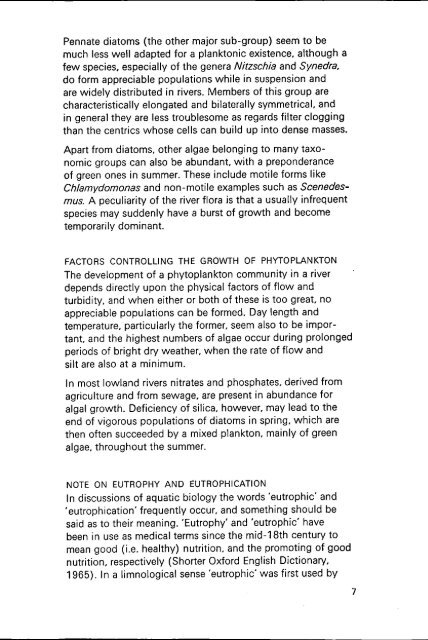Download (2189Kb) - NERC Open Research Archive - Natural ...
Download (2189Kb) - NERC Open Research Archive - Natural ...
Download (2189Kb) - NERC Open Research Archive - Natural ...
Create successful ePaper yourself
Turn your PDF publications into a flip-book with our unique Google optimized e-Paper software.
Pennate diatoms (the other major sub-group) seem to be<br />
much less well adapted for a planktonic existence, although a<br />
few species, especially of the genera Nitzschia and Synedra,<br />
do form appreciable populations while in suspension and<br />
are widely distributed in rivers. Members of this group are<br />
characteristically elongated and bilaterally symmetrical, and<br />
in general they are less troublesome as regards filter clogging<br />
than the centrics whose cells can build up into dense masses.<br />
Apart from diatoms, other algae belonging to many taxonomic<br />
groups can also be abundant, with a preponderance<br />
of green ones in summer. These include motile forms like<br />
Chlamydomonas and non-motile examples such as Scenedesmus.<br />
A peculiarity of the river flora is that a usually infrequent<br />
species may suddenly have a burst of growth and become<br />
temporarily dominant.<br />
FACTORS CONTROLLING THE GROWTH OF PHYTOPLANKTON<br />
The development of a phytoplankton community in a river<br />
depends directly upon the physical factors of flow and<br />
turbidity, and when either or both of these is too great, no<br />
appreciable populations can be formed. Day length and<br />
temperature, particularly the former, seem also to be important,<br />
and the highest numbers of algae occur during prolonged<br />
periods of bright dry weather, when the rate of flow and<br />
silt are also at a minimum.<br />
In most lowland rivers nitrates and phosphates, derived from<br />
agriculture and from sewage, are present in abundance for<br />
algal growth. Deficiency of silica, however, may lead to the<br />
end of vigorous populations of diatoms in spring, which are<br />
then often succeeded by a mixed plankton, mainly of green<br />
algae, throughout the summer.<br />
NOTE ON EUTROPHY AND EUTROPHICATION<br />
In discussions of aquatic biology the words 'eutrophic' and<br />
'eutrophication' frequently occur, and something should be<br />
said as to their meaning. 'Eutrophy' and 'eutrophic' have<br />
been in use as medical terms since the mid-18th century to<br />
mean good (i.e. healthy) nutrition, and the promoting of good<br />
nutrition, respectively (Shorter Oxford English Dictionary,<br />
1965). In a limnological sense 'eutrophic' was first used by<br />
7

















